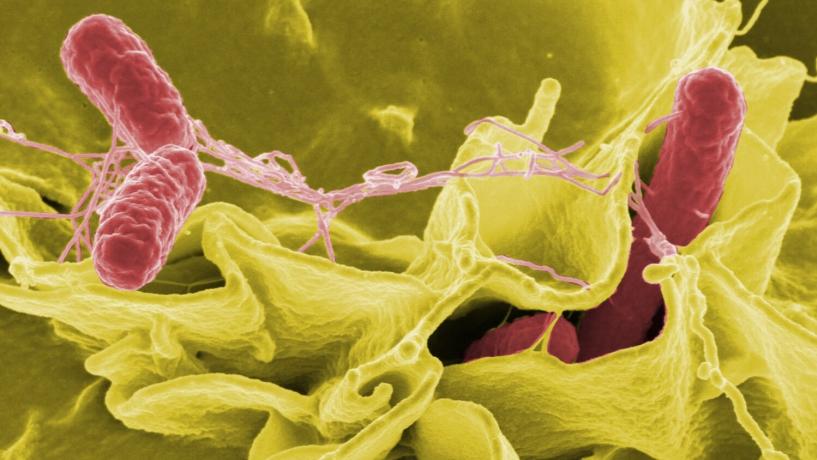
Salmonella is a bacterium that causes one of the most common intestinal infections in the developed world. Read on to learn more about this bacteria and how to avoid it.
Salmonellosis (the term used for illness caused by Salmonella) is caused when a person eats a food item containing a high number of salmonella bacteria. It can affect anyone but most reported cases are in children and young adults.
The severity of symptoms depends on how many bacteria are digested as well as the age and general health of the person that digested them.
History of Salmonella
Many believe that the first strain of Salmonella was discovered by veterinary scientist, Daniel E. Salmon. Although the bacterium is named after this man, it was actually first discovered by his assistant, Theobald Smith. In 1885 Smith discovered through his microscope - the short red rods that would later be known as Salmonella enterica.
When it was first discovered, Salmonella was initially thought to be the cause of Hog Cholera, or swine fever. For this reason, Salmon and Smith decided to name it "Hog-cholerabacillus".
The name Salmonella was not used until 1990, when Jose Liginieres suggested that the pathogen should be named Salmonella in Salmon's honour.
Foods Involved
Salmonella outbreaks are often linked to:
- raw or undercooked eggs,
- raw or undercooked meat and poultry and
- other foods that are high in protein such as fish, milk, custard and mayonnaise.
The world's most deadly Salmonella outbreak to date was related to milk. In 1985 in the Unites States, 6149 cases of Salmonella were reported amongst people who had consumed Bluebrook and Hillfarm 2% pasteurized milk. The outbreak forced the company to cease production of all dairy products.
Occasionally, fruits such as melons and tomatoes are also linked to Salmonella outbreaks. Australia has seen a number of concerning outbreaks of Salmonella in Rockmelon. In both 2006 and 2016, Food Standards Australia New Zealand (FSANZ) reported links between the pathogen and the fruit were rising in a number of states and territories.
Symptoms of Salmonellosis
The symptoms of Salmonellosis usually present themselves within 12 to 36 hours, but they could start as soon as 6 hours after consuming contaminated food, or may take up to 72 hours to present themselves.
The most common symptoms of Salmonellosis include:
- Diarrhoea
- Vomiting and Nausea
- Fever
- Headache
- Stomach Cramps
Common Causes of Transmission
Salmonellosis outbreaks are often a result of poor time and temperature control. This means that food containing the Salmonella bacteria is not cooked to the correct temperature for the correct amount of time.
Cross-contamination is also responsible for many Salmonella outbreaks. Equipment and utensils used to handle potentially hazardous foods such as meat or poultry must be thoroughly cleaned and sanitised to prevent Salmonella bacteria being transferred onto cooked or ready-to-eat foods.
If individuals are suffering from or have recently suffered from Salmonellosis do not wash their hands properly after using the toilet, the Salmonella bacteria can be spread to food and equipment.
Even though an individual may have only been suffering from Salmonellosis for a few days, the bacteria can be present in faeces for several weeks afterwards. In some cases, the bacteria can be carried for more than a year.
How you can Avoid Salmonella
The best method of prevention for Salmonellosis is to thoroughly cook all meat, poultry and egg dishes to the correct temperature for the correct amount of time. Time and Temperature play a vital part in the spread of pathogens and can become a major issue when keeping food safe.
Always follow good food safety practices. Clean and sanitise equipment and utensils after use, especially if you've been working with potentially hazardous foods. Cool cooked meats rapidly and refrigerate meat and poultry when not in use. Only prepare these foods in small batches to minimise the amount of time spent in the danger zone.
Those that work with food must not handle food if they are suffering from Salmonellosis. Managers should request a medical certificate before allowing them back to work and re-iterate the need for good personal hygiene and hand washing to prevent any risk of transmission.
Education plays a major role in the prevention of foodborne illnesses such as Salmonellosis. To find articles on other foodborne illnesses, visit our food safety blog and for further information on Food Safety training, see our Courses Page.
Now that you know about Salmonella and its associated dangers, you can use your knowledge to combat the spread of the pathogen at home and in the workplace.





